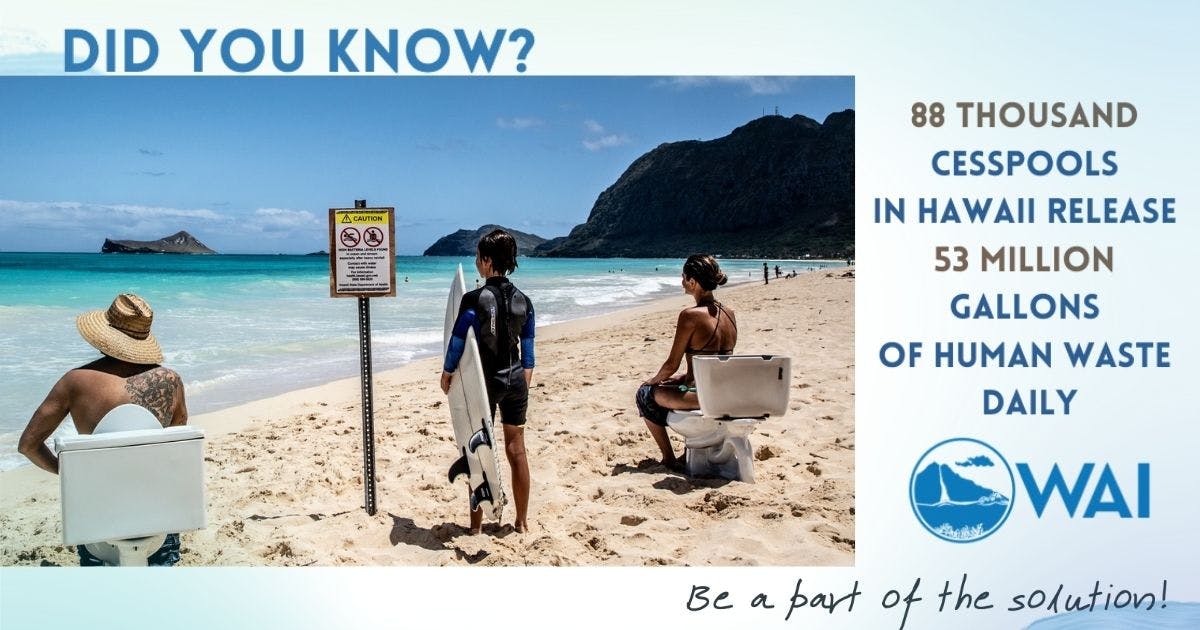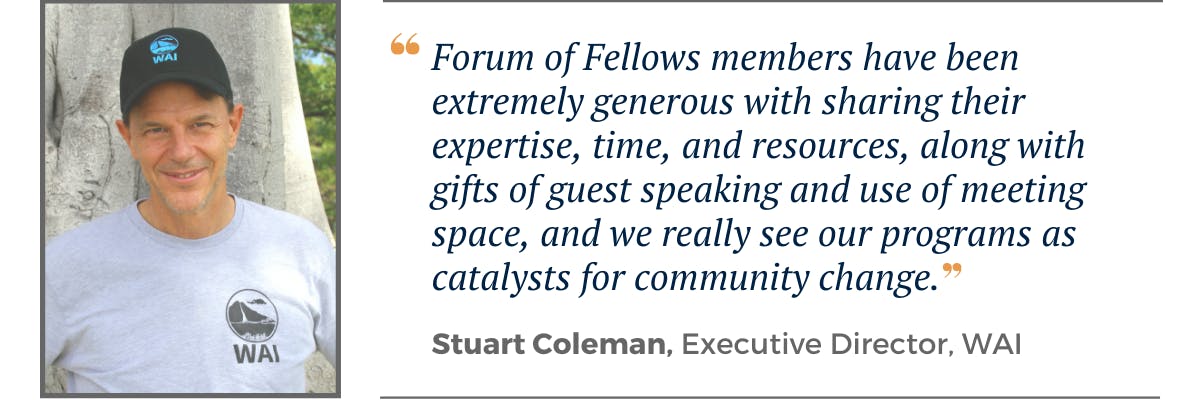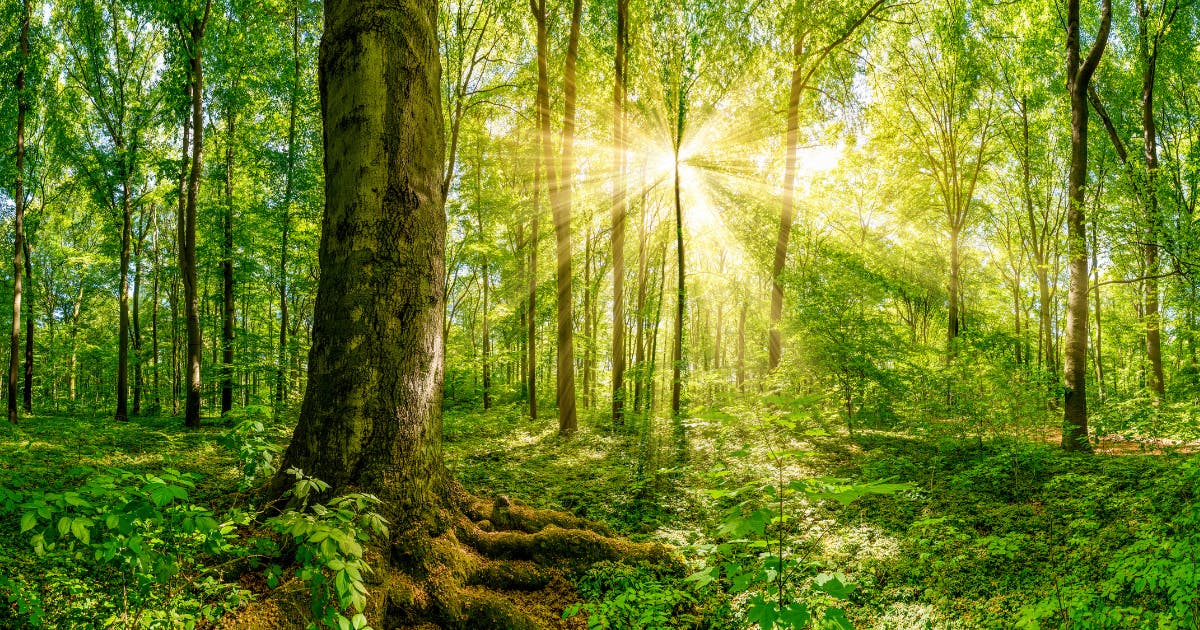Hawai‘i banned new cesspools in 2016, yet there are still thousands of cesspools that discharge millions of gallons of raw sewage into our waters each day. Cohort VI Fellow Stuart Coleman is committed to helping improve water quality across the state by reducing sewage pollution through his organization Wastewater Alternatives and Innovations (WAI).

Photo courtesy of WAI
In our Q&A, Stuart takes us through the who, what, when, and where of his journey to WAI, sharing the connection of his deep love of surfing and the ocean to the work he does today, and why he thinks WAI can help make Hawai‘i a leader in new sanitation technologies.
Hawai‘i Leadership Forum (HLF): Tell us about WAI – what are you doing and how do you hope to have impact?
Stuart Coleman (SC): WAI is not only our name but the Hawaiian word for water and the heart of our mission. We are committed to improving water quality by reducing the amount of sewage pollution from cesspools across the state that leach 53 million gallons of raw sewage into our groundwater and surface waters each day. That’s like a massive sewage spill every day in Hawaiʻi!
Our team at WAI is working to help homeowners, communities, and the state with the cesspool conversion process by introducing more efficient and affordable sanitation systems that reduce the risks to human health and environment. Though we were the last state to ban cesspools, we have an opportunity to make Hawaiʻi a leader in innovative new sanitation technologies, expand the wastewater industry, and build a workforce dedicated to improving our water quality across the state. We do this work through five pillars:
- Innovative Technology
- Financial Resources
- Policy & Advocacy
- Education & Outreach
- Successful Pilot Projects.
HLF: What was the spark that led to this journey you have been on? What personally motivated you to take on this work?
SC: As a surfer, I had always been interested in water quality because “crappy” water poses environmental and human health risks. Then, in 2006, a massive sewage spill of 48 million gallons was diverted into the Ala Wai Canal, closing down beaches for a week and making international headlines. That event deepened my interest in water quality and my work with the Surfrider Foundation. I soon learned that Hawaiʻi had the highest number of cesspools per capita in the country and began writing articles about this “crappy situation.”
Working with a coalition of groups, we helped pass laws banning cesspools and mandating their conversion by 2050. Serving on the Cesspool Conversion Working Group, I saw the need for a local nonprofit to help with the conversion process and the introduction of new sanitation technologies and policies. So, I started WAI with my partner John Anner in 2019.

HLF: How has your Omidyar Fellows experience and the Forum of Fellows contributed to this journey? How do you envision it might contribute in the future?
SC: The Omidyar Fellows program came at the perfect time in my life! The HLF Staff and my "Cohort VI compadres" helped me transition from being employed by nonprofits to starting my own organization and becoming a social entrepreneur. HLF Staff, along with Fellows George Yarbrough, Chris Lee, and Mahina Paishon helped me put on an Innovations in Sanitation Convening with the Bill & Melinda Gates Foundation and sparked my determination to start WAI; the collective support of the Forum of Fellows helped fan the flames and encouraged my desire to create my own organization; the Impact Funds provided the fuel to build the fire; and to extend this hot mess of a metaphor, SMALLIFY helped stoke the fire and transform our energy into several successful projects.
We created a pilot program at the Hawaiʻi Institute of Marine Biology to set up the first Cinderella Incineration Toilet in the Western U.S. We also partnered with Fellow Chris Lee and installed another incineration toilet at Kuilima Farm, and had a “Potty Party” to celebrate! These waterless toilets reduce sewage pollution, conserve water, and offer options for replacing cesspools in Hawaiʻi. We’ve received a lot of interest from other farms, government agencies, and rural communities.
WAI & Cinderella Eco Group Collaborate on Installation of Incineration Toilet at HIMB
Forum of Fellows members have been extremely generous with sharing their expertise, time, and resources, along with gifts of guest speaking and use of meeting space, and we really see our programs as catalysts for community change.
HLF: What challenges have you faced? How did you overcome or learn from them?
SC: It’s tough to start a new environmental nonprofit during a global pandemic. Three months after creating WAI, we were confronted with all the many health, economic, and logistical challenges of COVID-19. Like everyone else, we had to do a major pivot and think creatively about how to turn this crisis into a potential opportunity.
Cohort VII Fellow Rachel Solemsaas and I began brainstorming about ways to do workforce development around the cesspool issue. Partnering with the University of Hawaiʻi at Mānoa and Community Colleges, the Water Resources Research Center, and the Hawaiʻi Department of Health, we created the Work-4-Water Initiative. Based on the four goals of Workforce Development, Infrastructure Investment, Cesspool Replacement, and Water Protection, this initiative will train hundreds of displaced workers in the growing field of wastewater management to convert 400 cesspools across the state (100 in each county). Though it might seem like a crappy line of work, these are green jobs that pay well and help protect water quality and our most valuable natural resources.
HLF: What would you consider a success you’ve experienced on this journey? And how could that success be replicated in other situations?
SC: While looking for new innovative sanitation technology to bring to the state, I was introduced to a company called Cambrian Innovation, whose cutting-edge technology transforms wastewater into energy and recycled water. Cambrian was applying to be part of this year’s Elemental Excelerator (EEX) Cohort, and we began working with them, Pacific Current, and a team at EEX to find pilot projects in Hawaiʻi. Our team ended up winning a Deal Day Award, and Cambrian was selected to be part of this year’s cohort! We are working with them to introduce decentralized, package treatment plants in rural areas across the state. Through their unique Water Energy Purchase Agreement (WEPA), Cambrian offers “sanitation as a service” and requires no major capital costs up front.
This is just one small example of how we can introduce new technologies, policies, and financial structures to improve Hawaiʻi’s infrastructure; it’s also an example of how we can all work together for the common good.
Claire Sullivan, Cohort VII, shares two resources that celebrate and inspire multi-faceted wondering, one homegrown and the other from distant shores. May your year be full of good reading, conversing, and doing/not doing.
